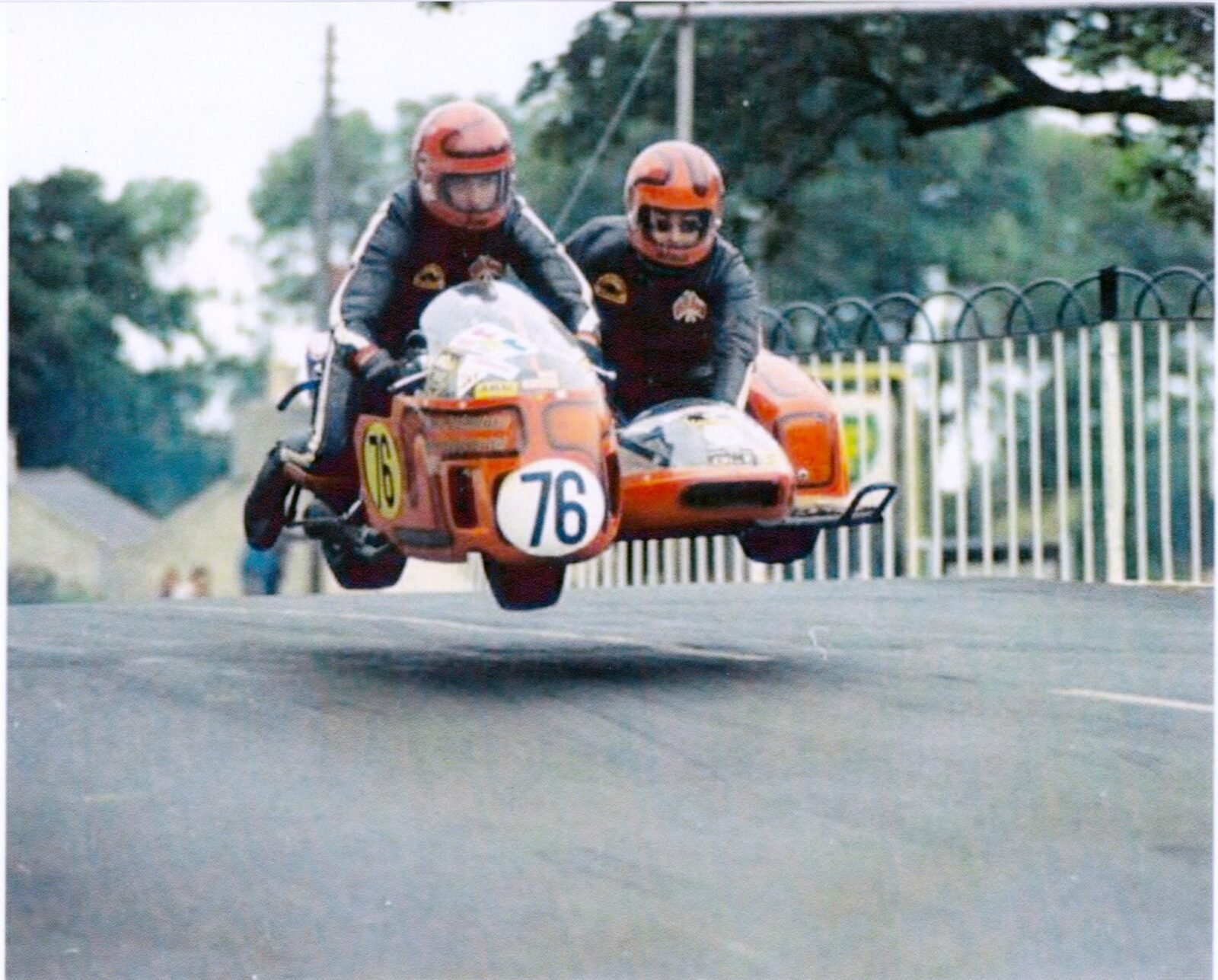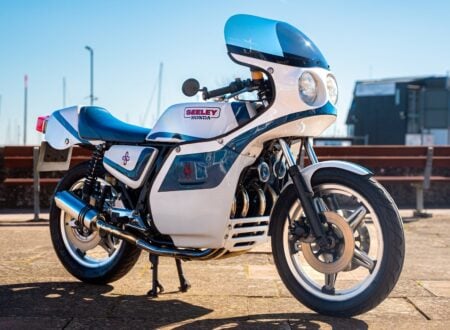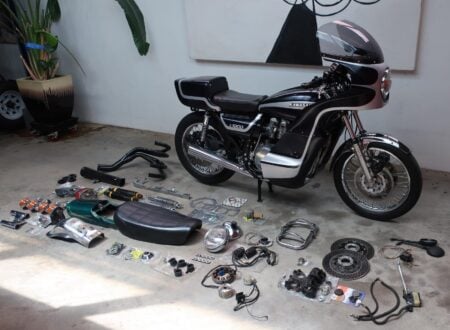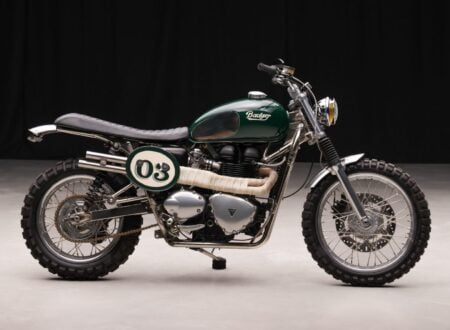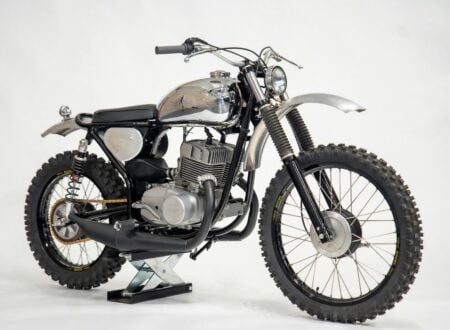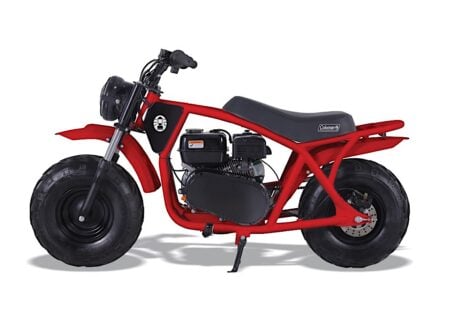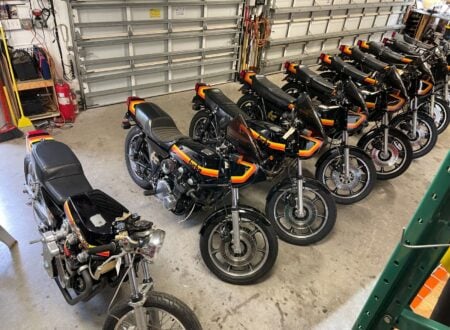Meet Joe and Alma Rocheleau
In the early 1960’s the Sidecar Racers’ Association was formed in Toronto which expanded to include competitors from all over Canada and the USA. It happened one day that a couple of Americans from Michigan travelled across to Canada to watch some motorcycle races at the Mosport circuit in Ontario. Their names were Joe and Alma Rocheleau. Joe was a motorcycle enthusiast who had become a member of the Detroit Highwaymen Motorcycle Club back in 1959. The Detroit Highwaymen were a fast riding motorcycle club, sufficiently fast that they needed to regularly replace the foot-pegs on their bikes – they get worn out if they’re constantly scraping the asphalt on corners.
Joe Rocheleau’s love affair with motorcycles and speed had begun with the Detroit Highwaymen but you can only go so fast on the road before the boys in blue decide you’re going rather more quickly than your safety permits. Every year Joe would go to the Mid-Winter banquet, held by the Windsor Motorcycling Club, where they would load up the old Bell & Howell 16mm projector with motorcycle racing films from Europe, including “ The Right Line” and the legendary Isle of Man Tourist Trophy races. Amidst the clacking of the projector, a dream was birthed in Joe’s mind of getting into motorcycle racing. Having been inspired by the films, the guys in the Detroit Highwaymen decided to find a way to do some real racing. Little did any of them realize that in years to come, one of them, in fact two of them, would make their way to the Isle of Man to make their mark on the TT.
In 1961 the Detroit Motorcycle Club organized their first race meeting – it was billed as “Michigan’s FIRST Motorcycle Combined Sportsmen Road Race”. The event was held on the 27th August in Waterford, Michigan and pre-sale tickets were a buck each whilst gate sales were a buck fifty. The club members raced their road bikes which were mostly British motorcycles although a couple of the guys had Harley-Davidson Sportsters. Seven club members entered in the “Open Class” and two in the “250 cc Class” with competitors from outside the club welcome. Joe Rocheleau’s bike suffered engine problems so he went from being in sixth place to being a “Failed to Finish”, but he was not to be discouraged; he’d been bitten by the racing bug. In 1962 Joe ponied up the cash to become the proud owner of a brand new Triumph Bonneville.
By 1963 the Triumph Bonneville was nicely broken in and so Joe went over the border to Canada to the Mosport race track in Ontario to try his luck in “International” competition. He finished the Open Class Race in the top fifteen of a twenty five to thirty bike field. Joe continued periodically entering competitions but something was about to happen that would change his life, and that would ultimately see him competing in the Isle of Man TT, but not in the event he might have expected.
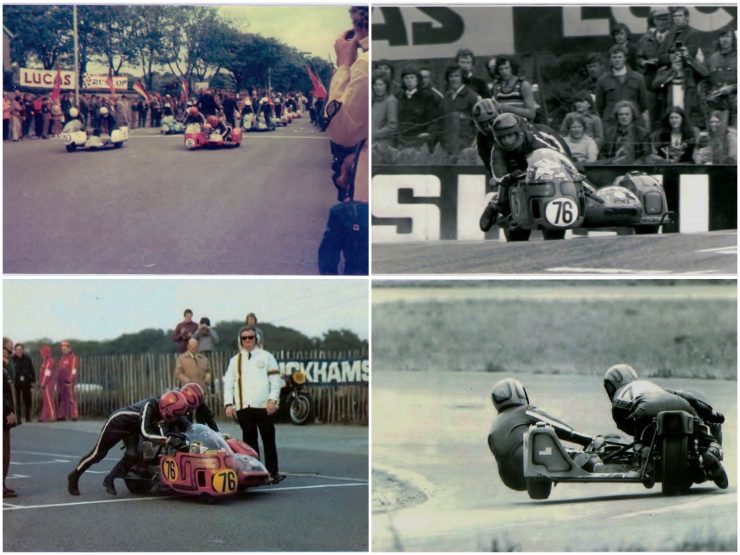
Enter Alma
Joe was invited out on a “blind date” on which he met Alma. The two shared an interest in each other and in motorcycles and to cut a long story short they were married in 1967. With a wife who was enthusiastic about motorcycle riding and racing, Joe was able to buy a custom 100cc Yamaha twin to compete in the 125cc class. Joe spent some time with the little “Yammy” in bits whilst he modified the engine which included drilling holes in the connecting rods to lighten them, so its red line went from 12,000rpm to a fairly screaming 16,000rpm. On this much smaller bike, Joe had to learn about sustaining his speed through the corners, rather than relying on the power of the Triumph Bonneville to power out of the corners and down the straightaways. Then in 1968, Joe bought his first real factory made racing bike, a 125cc Maico on which he first began to find himself on the winner’s podium.
The Sidecar Beginnings
It was in 1968 at the Canadian Mosport track that Joe and Alma first saw motorcycle sidecar racing. Joe said to Alma “That looks like fun”; Alma said to Joe “Yes, I think we should try it”. With smiles on both sides it didn’t take long for Joe and Alma to decide that a racing sidecar outfit would be a fun way for their husband and wife team to make their mark in the world of motorcycle racing. Little did they know then just how far that decision would take them.
Friends in the club were not so sure that Alma would really go through with being Joe’s sidecar sidekick – the naysayers were to be proven wrong however. Alma had been on some high speed club runs and had acquired a taste for speed. So for those who claimed Alma would quit after the first race, she simply told them to put their money where their mouth was. They did, and of course that made her more determined than ever to follow through and succeed as she imagined the sound of those crisp banknotes making their way into her purse.
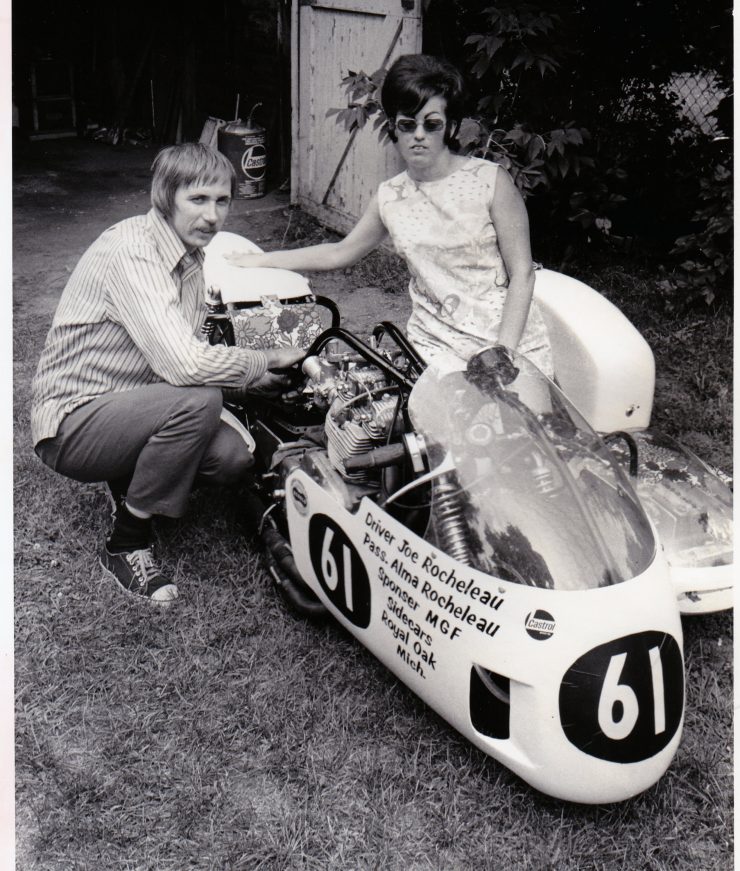
Joe and Alma’s First Sidecar Rig
In the fall of 1968, a friend of Joe’s who had been a passenger on a racing sidecar knew of a secondhand rig for sale. The unit was powered by a 650cc BSA parallel twin. Joe shelled out the shekels and bought it. Next came the workshop time to get the rig ready for the 1969 race season. As the warmth of spring melted the winter away in early 1969 the sidecar racer was ready for action. This was to be the acid test for Joe and Alma, neither had tried this before and certainly hadn’t tried to race as a team. It’s not often that a husband and wife will enter as a team into a competition in which the risks are as high as in motorcycle sidecar competition. But as the spring flowers bloomed and the landscape came to life, Joe and Alma moved into a new phase of life together in the fast lane.
It was in that spring of 1969 that some road racer friends of Joe and Alma’s rented a race track to get in some early practice before the season began in earnest and so Joe and Alma were invited to come along and practice also. Some of these friends had bet Alma that she would not succeed and perhaps they were hoping to collect on their bets. Or perhaps they really wanted the couple to succeed and were quite happy to open their wallets to Alma if she came through wearing the big smile of success. With the sidecar rig unloaded from the trailer, Joe and Alma’s turn to do some laps for the first time together came about. They first set out for some slow laps without wearing their leathers or helmets so they could work out their moves on the sidecar rig. Alma in particular, as the passenger, had to move around the rig, from hanging out the side on left hander corners, to moving in behind Joe for right hand corners, and to hold hard during braking. They took three slow laps to get the basic moves worked out, Then Joe and Alma pulled back into the pits. It was moment of truth time; Joe looked at Alma and asked “What do you think?” Alma looked back with a big smile filling her face and replied “I love it”. It was time to get into helmets and leathers and pick up the pace. Alma kept right on loving it, and as she collected the cash from the guys who said she’d never do it she loved it all the more.
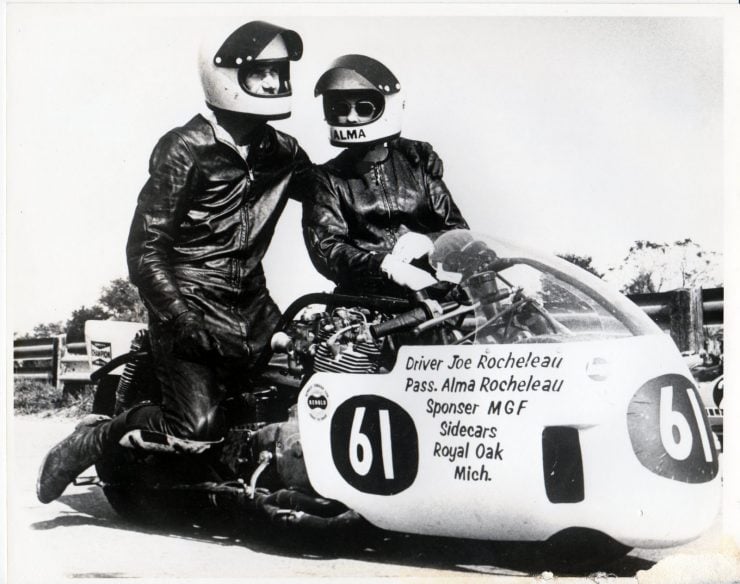
The sidecar was an old rig, but it was perfect to start sidecar racing on. When you first race anything be it a car, motorcycle, or sidecar rig Murphy’s Law is going to rear its ugly head and things that can go wrong will go wrong. In Joe and Alma’s sidecar rig, it was that parallel twin BSA engine that found the stress of racing to be a bit more than it could handle and it tended to break from time to time during the season. So as the leaves began to fall and Michigan turned a gorgeous shade of amber brown, the BSA engine was stripped down for a thorough winter overhaul. That overhaul paid off and Joe and Alma were able to at least finish in most of the races of the ’70 season. They both wanted to be more competitive and so at the end of the ’70 season, they purchased a bigger and better engine. What could be better for a racing sidecar rig than a tried and true 650cc BSA parallel twin? A 750cc ultra smooth BSA triple, the same engine as was used in the Triumph Trident and BSA Rocket 3, an engine that Joe and Alma hoped would rocket them onto the winner’s stand. For the ’72 season team Joe and Alma finished in the top seven against far more experienced competition. Not a first place medal yet, but surely knocking on the door.
A New Set Of Wheels
By now, Joe and Alma had realized that if they were going to commit to seriously competing in sidecar racing, and to do it as a husband and wife team, they would need a new sidecar rig. This would mean investing in the most up to date design sidecar rig available that would make them even more competitive. They bought a new M.G.F. Racing Sidecars “Ocelot” chassis with alloy wheels and fairing from Britain. The “Ocelot” chassis was designed to accommodate a Honda 500cc or 750cc engine but Joe decided to use the triple cylinder 750cc BSA engine and gearbox he already had that had so much smooth power. This meant a lot of “hands on” time in the garage because fittings had to be created including an oil tank, exhaust system, and the controls for the rig had to be created because you kneel down on a sidecar rig and so the foot controls have to be located at the back of the machine.
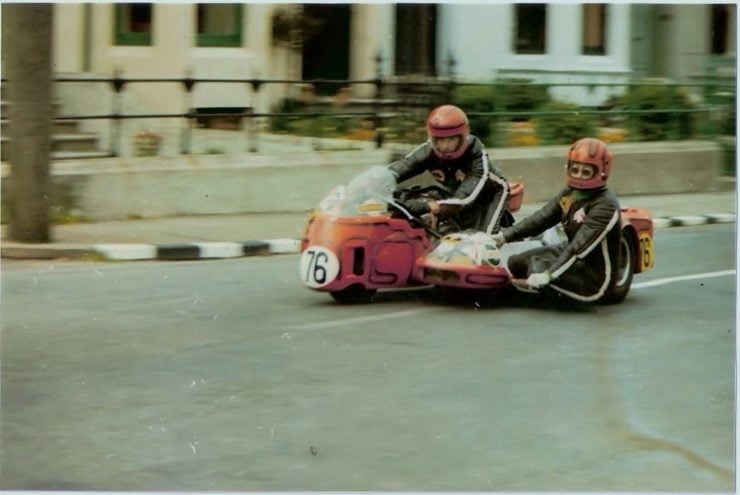
An Invitation to Race at the 1974 Isle of Man TT
The new sidecar rig made a huge difference. Joe and Alma were much faster and won several races. They finished the 1973 season as the top American team.
In February of 1974, Joe and Alma received the invitation of a lifetime. They were contacted by the Competition Director of the American Motorcycle Association who told them that because they were the top American sidecar team in the Sidecar Racers Association that they were to be given the only invitation the Association had for a sidecar team to enter the Isle of Man Tourist Trophy race. The only slight snag was that this was an “invitation” that did not guarantee a starting place for the race or include sponsorship. Joe and Alma would have to finance everything themselves. This was the chance to make a dream come true and they jumped at it.
In 1974 the Isle of Man TT was held in late May and early June, which is summer time in Britain and Ireland, but around the time for the TT races the weather was decidedly not summery. The gloomy weather was made even more gloomy when Joe and Alma arrived at their hotel on the Isle of Man to discover that their sidecar rig was still in Liverpool, which is a hundred miles across the Irish Sea away. Joe had to fly back to Liverpool to see what the problem was and to find a solution to the problem of the unmoving sidecar racer crate. It turned out that the crate that the sidecar rig was in was too wide to fit into the hold of the cargo aircraft that was to transport it. This called for some lateral thinking. Would Joe have to unpack and re-assemble the sidecar rig to ride it to the Isle of Man Ferry pier? No he wouldn’t although he was prepared to do it and in all probability back in swinging seventies Britain the local constabulary would have very likely helped him to accomplish that. But a little lateral thinking saved all that drama. Joe knew that the crate containing the bike could be tipped up on its side without risk of damage to the bike. With the crate tipped up on its side it neatly fit into the cargo hold of the aircraft and was able to wing its way to the Isle of Man.
The Isle of Man TT was run over a 37½ mile course on paved public roads and made its way through three small towns. The course included over 200 turns, a jump at Ballaugh Bridge where you will be airborne, and a section that went over Snaefell Mountain. The ’74 event was held over a two week period, the first week being for practice and qualifying and the second week for the actual competition. The Isle of Man TT is not a nice safe tourist drive around a picturesque island. Motor sport is dangerous and motor sport involving motorcycles with or without sidecars all the more so. In 1974 there were two fatalities, Briton Peter L. Hardy was killed during sidecar practice on 27th May and another Briton David J. Nixon was killed in the 1000cc Production TT on 1st June. So as Joe and Alma made their preparations to race “the mountain” they were well aware that this would be the ride of their lives.
Qualifying
The entry that Joe and Alma had received gave them the opportunity to qualify to participate in the actual race. In order to qualify they had to be able to complete a lap of that 37½ mile course in 33 minutes or less. That means completing the course with an average speed in excess of 62mph. The course itself is made up of closed off public roads with lots of dips and hills which means, for sidecar teams, there is often limited or no visibility as you crest a hill and find a bend just over it. This is because a sidecar team sits much lower than a solo racer sits and so the sidecar teams cannot see as far down the road as the solo racers. In order to race the course successfully the rider and passenger needed to learn the course so well that they were prepared for the invisible turn just over the next hill. With 1½ hours practice in the morning and another 1½ hours in the afternoon, Joe and Alma got busy learning the course and as they did so their lap times began to drop down from 35 minutes until they surprised themselves with 29 minute laps. They qualified, next was the race itself.
There were almost 100 entries in the 750cc sidecar class, with 74 sidecars qualifying for the race. Of those 74 only 34 managed to finish the race.
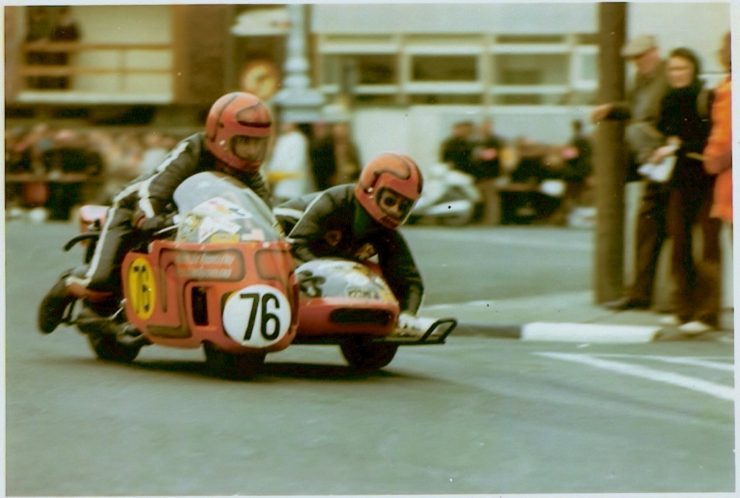
The Race
The sidecar race was scheduled for Saturday, but heavy fog on Snaefell Mountain meant that the race had to be postponed until Monday in the hope of clear skies. Sunday was not available for racing but is generally known as “Mad Sunday” because the course was thrown open for the spectators to ride and enjoy. There were about 100,000 spectators, many with motorcycles, and the sheer notion of all those young guys with motorcycles trying to be Isle of Man TT racers at the same time should paint a picture in your mind of just why it is called “Mad Sunday”.
Monday came and the skies had indeed cleared so the moment of truth for Joe and Alma had come. The sidecar rig had been placed in the pits on Sunday night race to be ready after the “madness” was over. Joe and Alma arrived at the pits early Monday to get into leathers and helmets and warm up the sidecar rig. The horn sounded and they got their bike into its starting position. At the Isle of Man TT the competitors are started in pairs at ten second intervals and as the starting flag falls, you’re racing the clock in the race of your life. Alongside the starting grid were Boy Scouts each holding the flags of a country that were competing in this event. As Joe and Alma approached the starting grid they saw the Stars and Stripes and had that wonderful realization that they were there representing the United States in what qualifies as the “Olympic Games” of motorcycle sport.
Before the flag dropped for Joe and Alma, seventy four other sidecar racers had left the starting grid. Back then, all the races were started with engines OFF. So when the starter dropped the flag you had to push and bump to start your engine to start the race. Joe and Alma held hands and looked at each other for one last pre-race glance. Then it was, ignition on, engage first gear, ready! The starter waved the starting flag and the run began, two steps for Alma and jump on, three steps for Joe and jump on side saddle and released the clutch, the BSA triple growls into life then roars, as team Joe and Alma burst off the starting grid and shift into second as they blast into Glencrutchery Road down Bray Hill and into the first turn at Quarter Bridge; the game was on. Seventeen miles out from that starting grid they make the jump at Ballaugh Bridge; Evel Knievel once wisely said “Anybody can jump a motorcycle. The trouble begins when you try to land it.”, Joe and Alma make the landing safely as the 750cc BSA “Rocket” engine pours power back onto the bitumen propelling them onwards. Evel Knievel also said “Where there is little risk, there is little reward.”
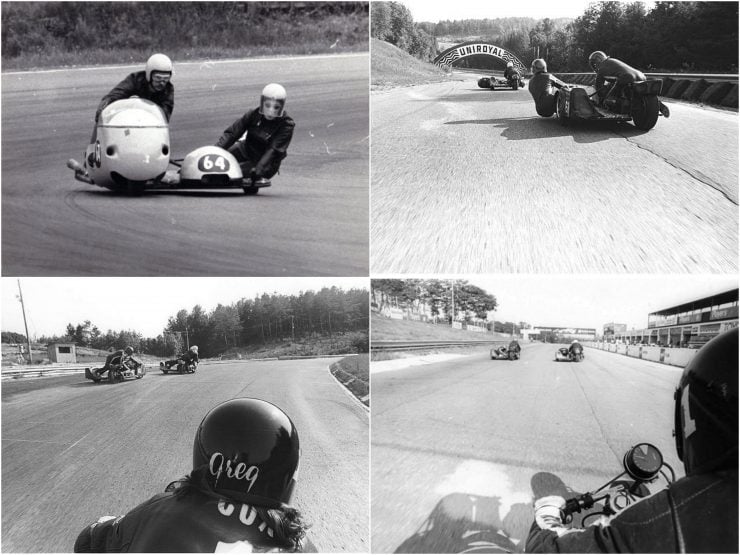
The trouble for Joe and Alma was not with the landing at Ballaugh Bridge but it reared its ugly head at the hairpin at Ramsey Corner. Ramsey Corner is a sharp first gear left hander a little over twenty four miles from the start. If you’ve had the opportunity to do any road racing on four, three or two wheels you’ll know that braking is left to the last minute and it’s done hard because you don’t want to lose any speed until the last possible second. On the approach to Ramsey Corner Joe and Alma go from full throttle to hard braking, timing the braking to just get their speed down enough to make the hairpin turn. As they approach the corner, the flagman is not signalling danger so they round the corner, Joe opens the throttle and suddenly things come unglued at racing speed and before they know it the bike has snapped around and flipped Alma over Joe in an almost graceful arc knocking Joe off the bike as well. The stunned pair lose no time, both are OK, the bike landed on its wheels and is OK, so its back into the saddle, push start to get the engine going and throttle open to make up those lost seconds. It would not be until the second lap that Joe and Alma would find out what had really happened. Approaching the Ramsey hairpin for the second time, the flagman was enthusiastically waving to say “oil on the track”, something he should have been doing on Joe and Alma’s first lap!
Other than the slip and flip at Ramsey hairpin on lap one, Joe and Alma conquered Snaefell Mountain and quite enjoyed their Evel Knievel airborne experiences at Ballaugh Bridge. Only 1 in 10 rookies actually manage to finish their first Isle of Man TT but Joe and Alma were in that privileged 10 percent and their names went into the history of the Isle of Man TT finishing in a respectable 30th place, after starting 76th. Not only that, but they were and still are the only American husband and wife team to compete in the Isle of Man TT sidecar event.
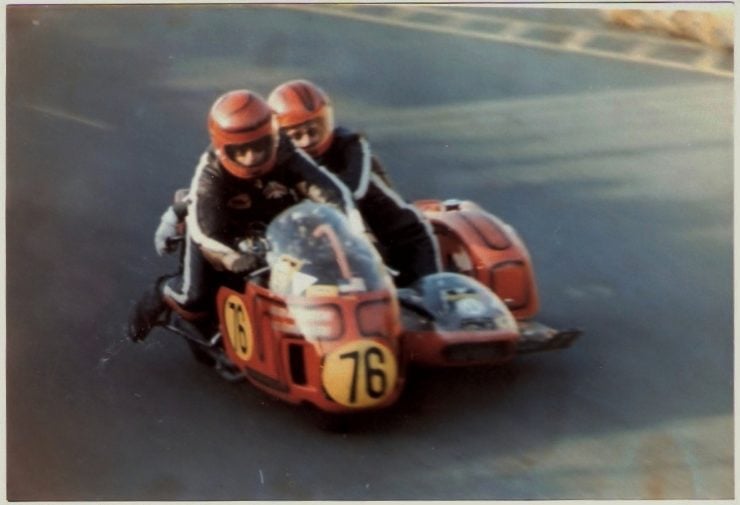
A Return to the USA
Joe and Alma returned to the United States and competed in sidecar races in the Midwest and Canada until 1982. They found themselves on the winners podium their fair share of times and even won a couple of championships. They were only able to compete in the Isle of Man TT once, in their “ride of a lifetime” in 1974, but having that one opportunity means they did something in their lives that few can attain.
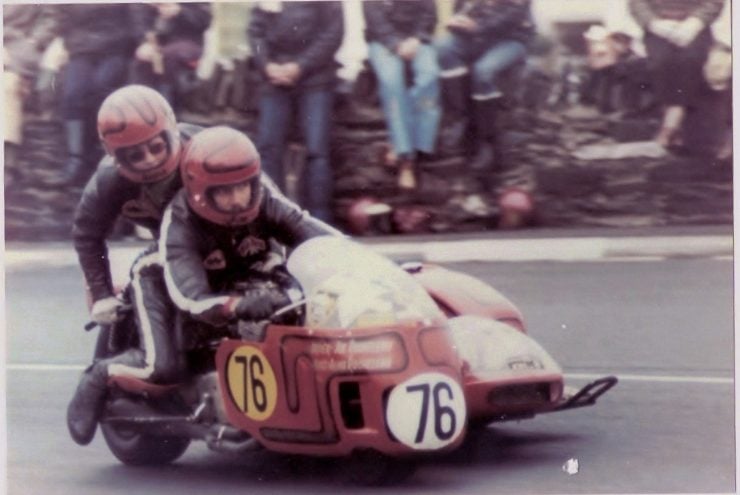
In Memory of Alma
Alma was a woman who knew what she wanted to get out of life and she was not someone to sit around wishing and hoping but she was someone who applied the “God helps those who help themselves” principle to the things she did. Joe of course, had a large dose of that also. It had been Alma who had first set eyes on Joe back in his Detroit Highwaymen days and said to her girlfriend “He’s the one I want”. She had some friends in the Highwaymen and so a blind date was arranged, which led to Joe deciding that Alma was the lady he wanted also, and so they were married, and she told Joe about how she helped him catch her about thirty years later.
There haven’t been many husband and wife motorcycle sidecar racing teams. To be such a team requires two people who are committed to each other and who trust each other implicitly in something in which you are each putting your lives on the line. Alma loved adventure, she loved going places with Joe and she loved doing things with Joe. She loved life and lived it to the full. In the movie Dead Poet’s Society the teacher exhorts his students to “Seize the day” – Alma chose to live like that and she lived that way until 2006 when she passed away after a battle with cancer. Before she left this life she wrote Joe a letter in which she ended with a simple loving thank you “We had a great ride”.
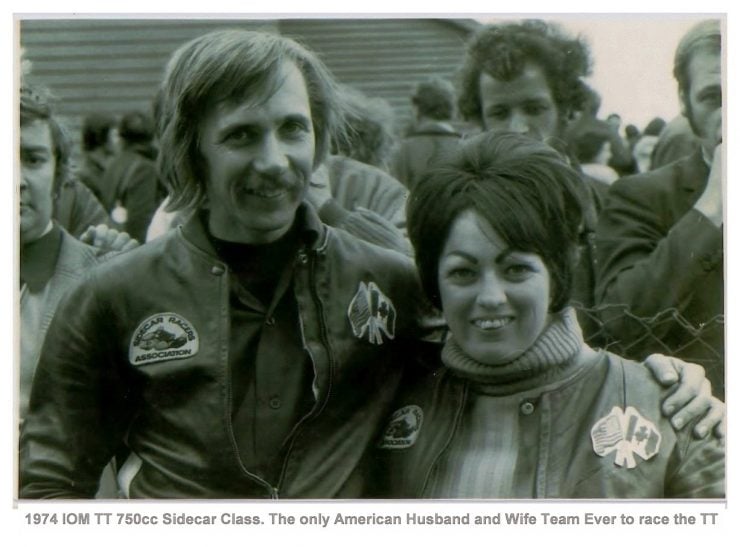
Words: Jon Branch
Images: Joe Rocheleau

